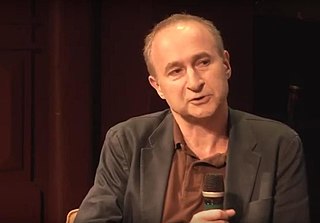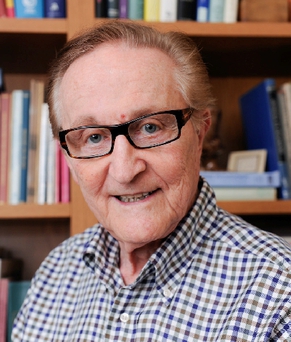Related Research Articles

Catatonia is a complex neuropsychiatric behavioral syndrome that is characterized by abnormal movements, immobility, abnormal behaviors, and withdrawal. The onset of catatonia can be acute or subtle and symptoms can wax, wane, or change during episodes. It has historically been related to schizophrenia, but catatonia is most often seen in mood disorders. It is now known that catatonic symptoms are nonspecific and may be observed in other mental, neurological, and medical conditions. Catatonia is not a stand-alone diagnosis, and the term is used to describe a feature of the underlying disorder.

Dementia praecox is a disused psychiatric diagnosis that originally designated a chronic, deteriorating psychotic disorder characterized by rapid cognitive disintegration, usually beginning in the late teens or early adulthood. Over the years, the term dementia praecox was gradually replaced by the term schizophrenia, which initially had a meaning that included what is today considered the autism spectrum.
Psychosis is a condition of the mind that results in difficulties determining what is real and what is not real. Symptoms may include delusions and hallucinations, among other features. Additional symptoms are incoherent speech and behavior that is inappropriate for a given situation. There may also be sleep problems, social withdrawal, lack of motivation, and difficulties carrying out daily activities. Psychosis can have serious adverse outcomes.
Schizoaffective disorder is a mental disorder characterized by abnormal thought processes and an unstable mood. This diagnosis requires symptoms of both schizophrenia and a mood disorder: either bipolar disorder or depression. The main criterion is the presence of psychotic symptoms for at least two weeks without any mood symptoms. Schizoaffective disorder can often be misdiagnosed when the correct diagnosis may be psychotic depression, bipolar I disorder, schizophreniform disorder, or schizophrenia. This is a problem as treatment and prognosis differ greatly for most of these diagnoses.

A thought disorder (TD) is a disturbance in cognition which affects language, thought and communication. Psychiatric and psychological glossaries in 2015 and 2017 identified thought disorders as encompassing poverty of ideas, neologisms, paralogia, word salad, and delusions - all disturbances of thought content and form. Two specific terms have been suggested — content thought disorder (CTD) and formal thought disorder (FTD). CTD has been defined as a thought disturbance characterized by multiple fragmented delusions, and the term thought disorder is often used to refer to an FTD: a disruption of the form of thought. Also known as disorganized thinking, FTD results in disorganized speech and is recognized as a major feature of schizophrenia and other psychoses. Disorganized speech leads to an inference of disorganized thought. Thought disorders include derailment, pressured speech, poverty of speech, tangentiality, verbigeration, and thought blocking. One of the first known cases of thought disorders, or specifically OCD as we know it today, was in 1691. John Moore, who was a bishop, had a speech in front of Queen Mary II, about "religious melancholy."
Biological psychiatry or biopsychiatry is an approach to psychiatry that aims to understand mental disorder in terms of the biological function of the nervous system. It is interdisciplinary in its approach and draws on sciences such as neuroscience, psychopharmacology, biochemistry, genetics, epigenetics and physiology to investigate the biological bases of behavior and psychopathology. Biopsychiatry is the branch of medicine which deals with the study of the biological function of the nervous system in mental disorders.
Intermetamorphosis is a delusional misidentification syndrome, related to agnosia. The main symptoms consist of patients believing that they can see others change into someone else in both external appearance and internal personality. The disorder is usually comorbid with neurological disorders or mental disorders. The disorder was first described in 1932 by Paul Courbon (1879–1958), a French psychiatrist. Intermetamorphosis is rare, although issues with diagnostics and comorbidity may lead to under-reporting.

Jim van Os is a Dutch academic and psychiatrist. He is Professor of Psychiatry and medical manager of the Brain Center at Utrecht University Medical Center, the Netherlands.
Neuropsychiatry is a branch of medicine that deals with psychiatry as it relates to neurology, in an effort to understand and attribute behavior to the interaction of neurobiology and social psychology factors. Within neuropsychiatry, the mind is considered "as an emergent property of the brain", whereas other behavioral and neurological specialties might consider the two as separate entities. Those disciplines are typically practiced separately.

Grandiose delusions (GD), also known as delusions of grandeur or expansive delusions, are a subtype of delusion that occur in patients with a wide range of psychiatric disorders, including two-thirds of patients in a manic state of bipolar disorder, half of those with schizophrenia, patients with the grandiose subtype of delusional disorder, frequently in narcissistic personality disorder, and a substantial portion of those with substance abuse disorders. GDs are characterized by fantastical beliefs that one is famous, omnipotent, wealthy, or otherwise very powerful. The delusions are generally fantastic and typically have a religious, science fictional, or supernatural theme. There is a relative lack of research into GD, in contrast to persecutory delusions and auditory hallucinations. Around 10% of healthy people experience grandiose thoughts at some point in their lives but do not meet full criteria for a diagnosis of GD.

Postpartum psychosis(PPP), also known as puerperal psychosis or peripartum psychosis, involves the abrupt onset of psychotic symptoms shortly following childbirth, typically within two weeks of delivery but less than 4 weeks postpartum. PPP is a condition currently represented under "Brief Psychotic Disorder" in the Diagnostic and Statistical Manual of Mental Disorders, Volume V (DSM-V). Symptoms may include delusions, hallucinations, disorganized speech (e.g, incoherent speech), and/or abnormal motor behavior (e.g., catatonia). Other symptoms frequently associated with PPP include confusion, disorganized thought, severe difficulty sleeping, variations of mood disorders (including depression, agitation, mania, or a combination of the above), as well as cognitive features such as consciousness that comes and goes (waxing and waning) or disorientation.

Jeffrey Alan Lieberman is an American psychiatrist who specializes in schizophrenia and related psychoses and their associated neuroscience (biology) and pharmacological treatment. He was principal investigator for CATIE, the largest and longest independent study ever funded by the United States National Institute of Mental Health to examine existing pharmacotherapies for schizophrenia. He was president of the American Psychiatric Association from May 2013 to May 2014.
Karl Murdock Bowman was a pioneer in the study of psychiatry. From 1944 to 1946 he was the president of the American Psychiatric Association. His work in alcoholism, schizophrenia, and homosexuality is particularly often cited.
Childhood schizophrenia is similar in characteristics of schizophrenia that develops at a later age, but has an onset before the age of 13 years, and is more difficult to diagnose. Schizophrenia is characterized by positive symptoms that can include hallucinations, delusions, and disorganized speech; negative symptoms, such as blunted affect and avolition and apathy, and a number of cognitive impairments. Differential diagnosis is problematic since several other neurodevelopmental disorders, including autism spectrum disorder, language disorder, and attention deficit hyperactivity disorder, also have signs and symptoms similar to childhood-onset schizophrenia.
The diagnosis of schizophrenia, a psychotic disorder, is based on criteria in either the American Psychiatric Association's Diagnostic and Statistical Manual of Mental Disorders, or the World Health Organization's International Classification of Diseases (ICD). Clinical assessment of schizophrenia is carried out by a mental health professional based on observed behavior, reported experiences, and reports of others familiar with the person. Diagnosis is usually made by a psychiatrist. Associated symptoms occur along a continuum in the population and must reach a certain severity and level of impairment before a diagnosis is made. Schizophrenia has a prevalence rate of 0.3-0.7% in the United States
Dilip V. Jeste is an American geriatric neuropsychiatrist, who specializes in successful aging as well as schizophrenia and other psychotic disorders in older adults. He was senior associate dean for healthy aging and senior care, distinguished professor of psychiatry and neurosciences, Estelle and Edgar Levi Memorial Chair in Aging, director of the Sam and Rose Stein Institute for Research on Aging, and co-director of the IBM-UCSD Artificial Intelligence Center for Healthy Living at the University of California, San Diego School of Medicine. after serving for 36 years, he retired from UC San Diego on July 1, 2022.
F. Markus Leweke is a German psychiatrist and psychotherapist. He is a professor and Chair in Youth Depression Studies at the Brain and Mind Centre of the University of Sydney, Australia and a work group leader at the Central Institute of Mental Health in Mannheim, Germany.
Ming Tso Tsuang is an American psychiatrist and Distinguished Professor of Psychiatry at the University of California, San Diego. He is considered a pioneering researcher in the genetic epidemiology of schizophrenia and other severe mental disorders. Tsuang has authored and co-authored more than 600 publications and serves as founding and senior editor of the American Journal of Medical Genetics Part B.

Kenneth Z. Altshuler was an American psychiatrist and psychoanalyst. He was a Professor Emeritus of Psychiatry and the Chairman of the Department of Psychiatry at the University of Texas Southwestern Medical Center in Dallas.
Dolores Malaspina M.D., M.S., MSPH is an American psychiatrist and director of the psychiatry program at the Icahn School of Medicine at Mount Sinai and the Anita Steckler and Joseph Steckler Professor of Psychiatry at New York University School of Medicine and the director of InSPIRES, the Institute for Social and Psychiatric Initiatives.
References
- 1 2 "Academic Profile: Carol Tamminga, M.D." Retrieved 2022-05-28.
- 1 2 "Carol Tamminga, M.D.: Psychiatry | UT Southwestern Medical Center". utswmed.org. Retrieved 2019-03-24.
- ↑ "Past Outstanding Achievement Prizewinners". Brain & Behavior Research Foundation. 2017-04-11. Retrieved 2019-03-07.
- ↑ "Could An Antidepressant Help Kids With Down Syndrome?". Popular Science. Retrieved 2019-03-09.
- ↑ Bryan, Ellen. "Study Gives Prozac to Fetuses With Down Syndrome". NBC 5 Dallas-Fort Worth. Retrieved 2019-03-09.
- ↑ Carreon, David; Gold, Jessica (Aug 28, 2018). "The Last Undiscovered Organ in the Body". Psychiatric Times.
- ↑ "Carol Tamminga". utsouthwestern.edu. Retrieved May 12, 2017.
- ↑ "Questions". utsouthwestern.edu. Retrieved May 12, 2017.
- ↑ "Lab". utsouthwestern.edu. Retrieved May 12, 2017.
- ↑ "Edward Hekman, Official Of Biscuit Firm, USDA". The Washington Post. 1980-03-20. Retrieved 2022-05-28.
- 1 2 "Obituary: Sidney William Tamminga" . Retrieved 2022-05-28.